Why use this tool?
In order to embrace and embody new values that sustain the lives of all living beings, a key skill is that of listening without judging, in a spirit of empathy and compassion. This tool enables us to better understand how values vary among people and over time, to respect the perspectives of other people, to connect with the more-than-human world, as well as to become aware of the values we hold ourselves, which can either block us or move us towards more resilience, connection, creativity and regeneration. Because we are not used to listening without judging, this tool takes practice, and when mastered can positively affect all our relationships.
Activities in this Tool
Activity 3.3.1 Active listening
Activity 3.3.2 Deep listening with Others
Activity 3.3.2 Deep listening to Oneself
Activity 3.3.1 Active listening
Overview
Active Listening is a basic skill that can be used in any kind of situation and especially to help learners appreciate different perspectives, and to talk fearlessly about facts, beliefs, or emotions that they may otherwise tend to hide. The description of this activity is an introduction to working with Active Listening for learners and teachers who are not already familiar with it.
Curriculum linkage
- Language & Literature, Civics & Social Studies, Ethics, Religion & Philosophy.
Competences built
- Empathy, presence, critical thinking, integrity, active listening.
Basic info
- Age range: 6+, often a tool for teachers
- Duration: 50 minutes in class + prep work
- Group size: Flexible. The group will be divided into pairs.
- Level of difficulty: Basic
- Materials/space required:
- Places for quiet conversation – quiet corners, group rooms or outside space that give room for private reflections.
- Location: Indoors or outdoors
- Engagement of external stakeholders: No
Prep Work
- Start by watching this interview. In addition to listening, in Active Listening you work with your body in giving response by nodding as well as feedback by humming attentively. This is very well illustrated in this Tedx Talk.
- Prepare prompts in the form of questions for the class. Some examples are given below.
Steps in the activity
- Set the scene and sharpen your senses
- Introduce active listening
- Active listening sessions 1 & 2
- Reflection
Steps
Please note that the steps below can also be practiced as stand alone activities once the learners have understood the principles of active listening.
Step 1 : Set the scene and sharpen your senses (15 minutes, optional)
This step is optional and you can start with step 2 directly if you prefer.
- Start by playing a game.
- First stand or sit in a circle.
- Invite everybody to come up with a simple movement to express how they feel right now – without using words.
- Go around the circle and let everybody express their feeling and if possible timewise, also let the group mimic each learner’s movement.
- Invite reflections among the group, focusing on the two questions below:
- Did you understand what the others meant when expressing a feeling/emotion?
- Was it easy or difficult to understand?
Step 2: Introduce Active Listening (10 minutes)
- Make sure this activity is practised on a voluntary basis, by explaining what the activity is about. Let them know that all information exchanged through the exercise should remain confidential.
- Organise the learners in pairs, in an environment where they feel secure and in a way so they can see each other’s expressions.
- If there are two teachers in the room, you could introduce active listening by performing a short demonstration showing the opposite of active listening (looking away, tapping your foot impatiently, looking at your phone). Follow up by asking the other teacher how this made them feel, and ask the learners what you can do to be a better listener, and probably the learners will come up with many of the principles of active listening.
- Introduce key principles to active listening:
- Let the other person talk without interruption.
- Give space to each other – a little silence gives the listener time to respond and the speaker to reflect.
- When posing questions, after the speaker has spoken, first let there be a moment of silence and then use open questions, for example: what…, how….
- Repeat or rephrase key words or sentences you heard
- Give feedback by highlighting some of the topics, or summarising
- Close the introduction by opening up for questions for 3 minutes.
Step 3: Active Listening Sessions 1 & 2 (12 minutes)
- Invite learners to take on the roles of the speaker and the listener for the first session, using the questions you prepared in advance. The speaker may rephrase the question if needed and is free to speak at their own pace. Regarding the listener, a suggestion is to choose and practise one or two of the listening key principles. The listener can invite the speaker to begin by asking: what are your thoughts about…
- Let the speaker talk for five minutes.
- Now you ask them to switch roles and repeat the exercise.
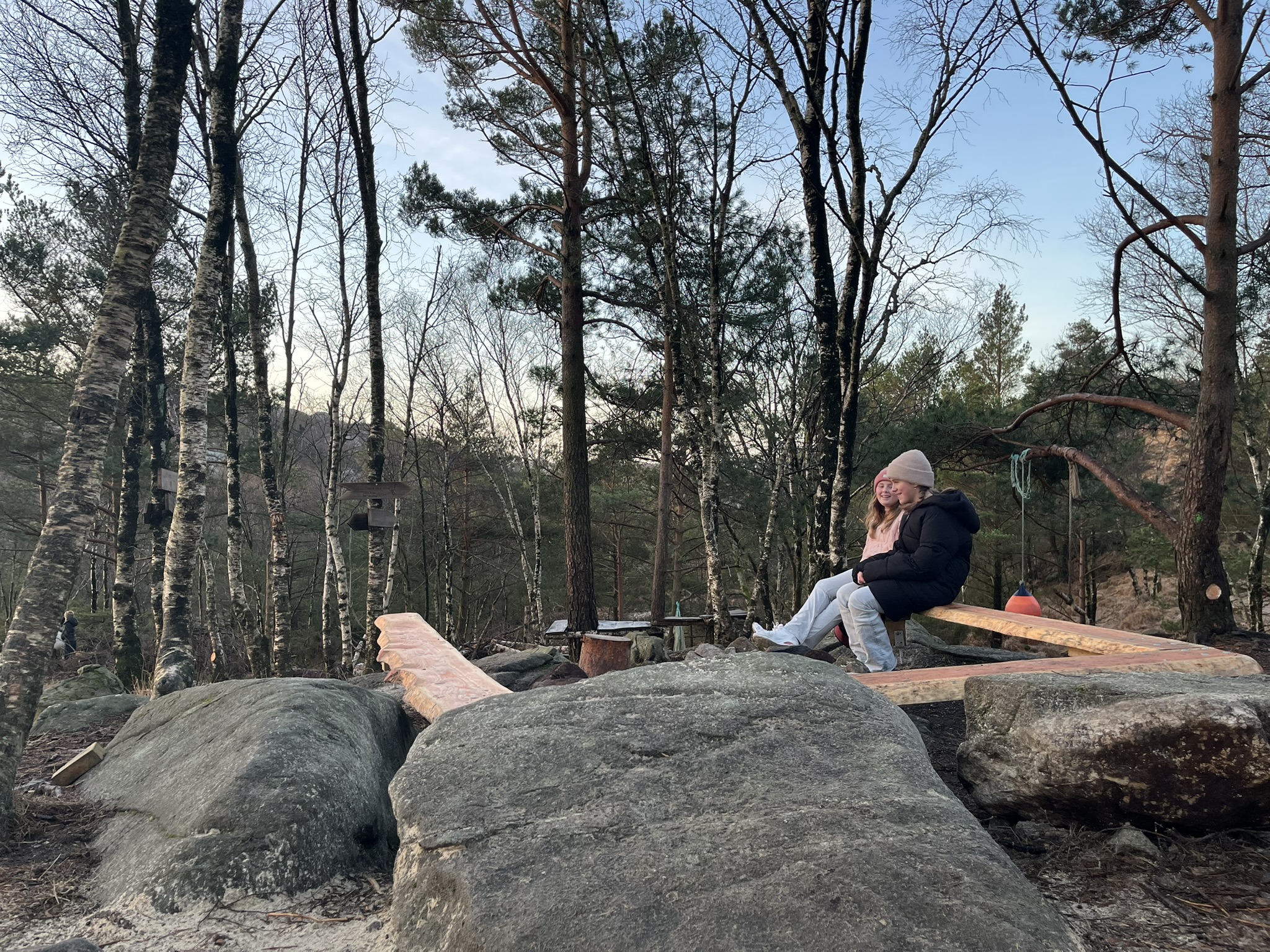
Learners in pairs and trios during active listening in a nature area. Photo: Marte Maurabakken/Climate Creativity.
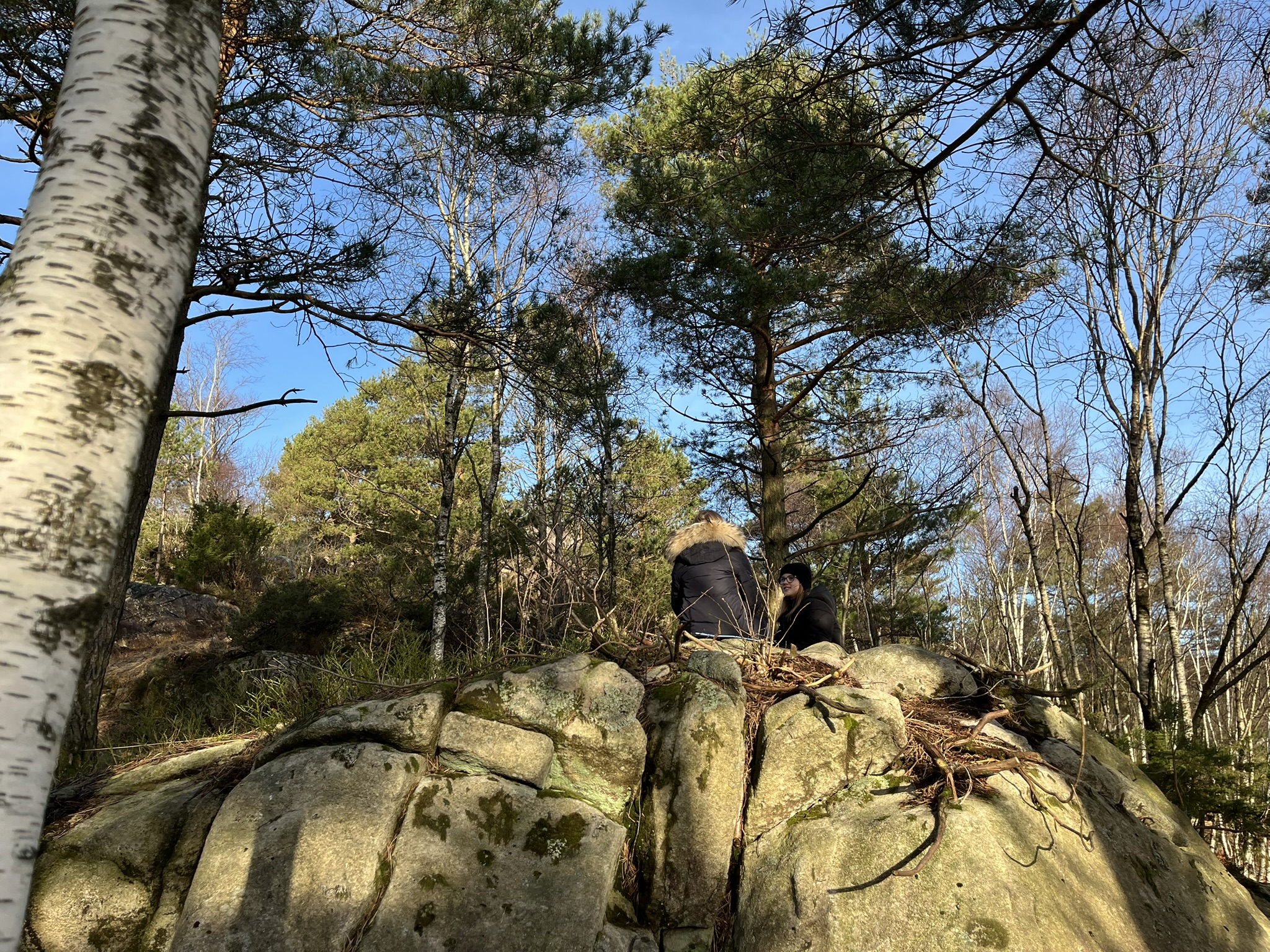
Learners in pairs and trios during active listening in a nature area. Photo: Marte Maurabakken/Climate Creativity.
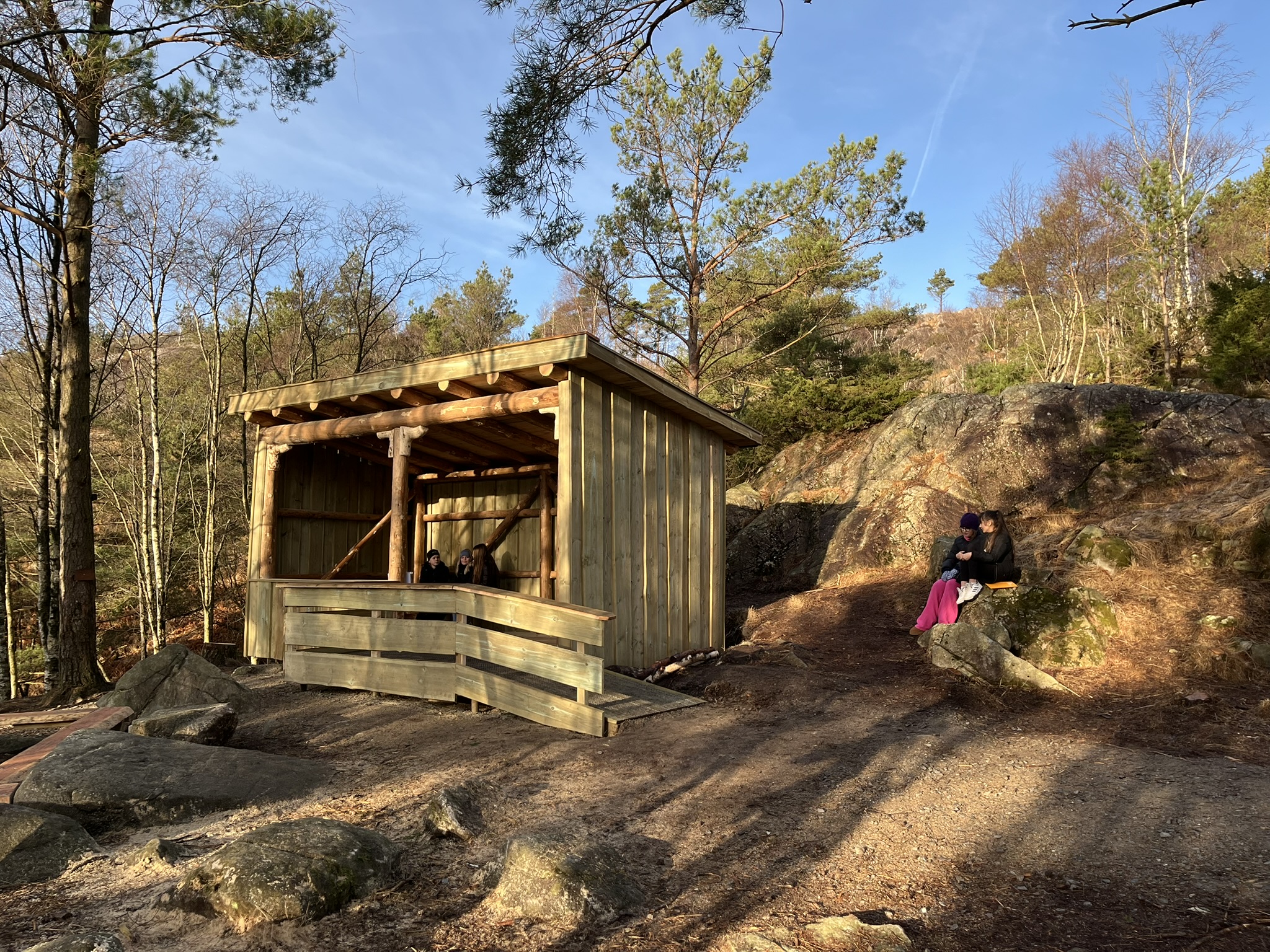
Learners in pairs and trios during active listening in a nature area. Photo: Marte Maurabakken/Climate Creativity.
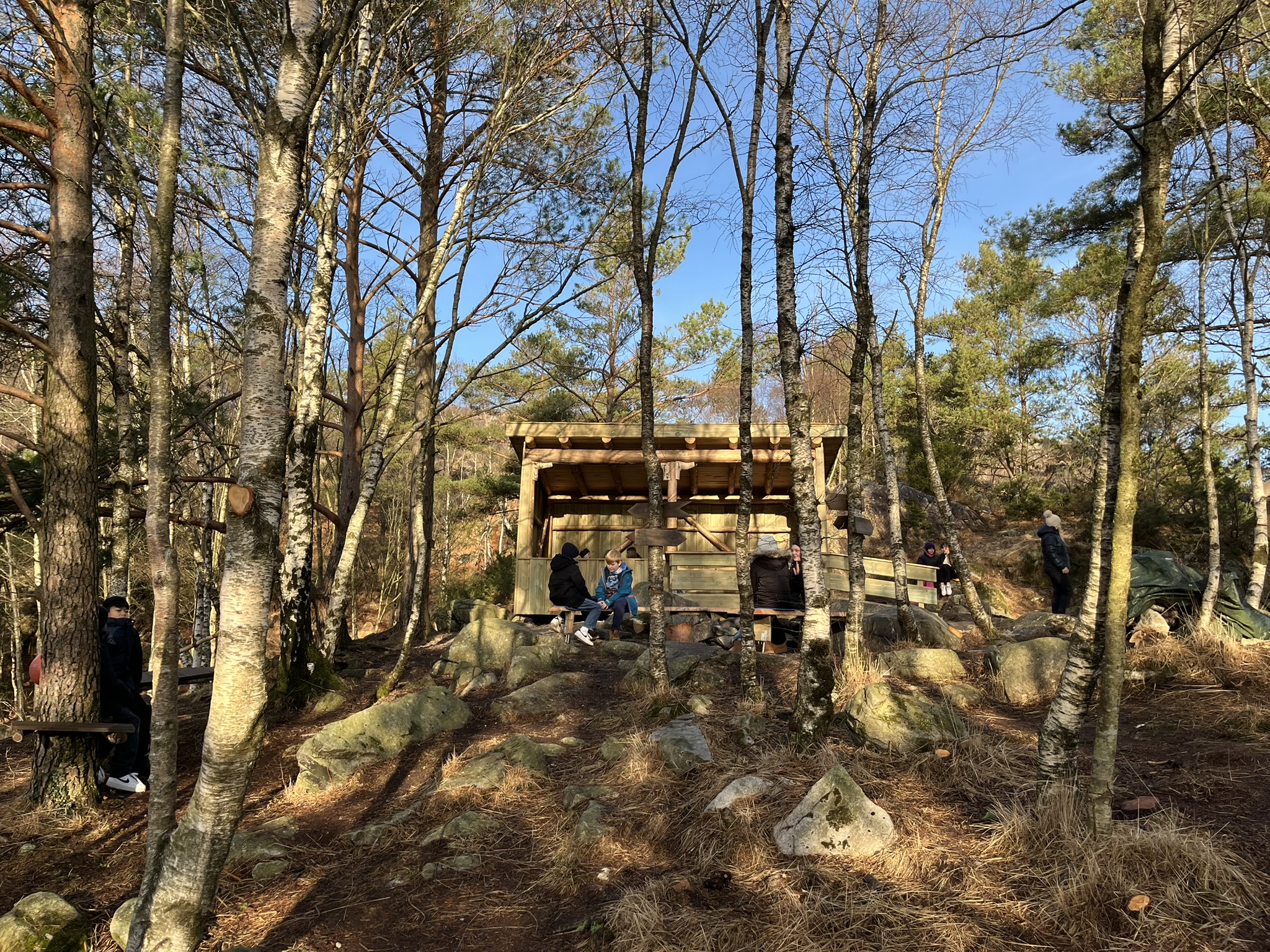
Learners in pairs and trios during active listening in a nature area. Photo: Marte Maurabakken/Climate Creativity.
Step 4: Reflection (10 minutes)
- Invite the learners to reflect for themselves and write down their thoughts for 2 minutes. Guiding questions can be:
- How did it feel to listen?
- How did it feel to be heard?
- Invite the learners to reflect together on the exercise for 2 minutes.
- Reflect as a whole group for 5 minutes.
- Write down some takeaways.
Adaptations
We invite you to adapt this activity to the specific needs of your learners, including by taking into account their neurodiversity. When adapting tools and activities for neurodivergent learners, please note it is not about treating others how you want to be treated, but how they want to be treated. Ask, listen, and stay open to different ways of learning and engaging.
Example of prompts:
- Describe a place you like, and where you feel calm or safe.
- Tell about a time when someone helped you – or when you helped someone else.
- Share something you care about when it comes to nature or the climate.
If your learners are young, you may wish to start by introducing only one or two of the key principles of active listening. For example, these:
- Let the other person talk without interruption.
- When you don’t understand, try to use open questions, for example: what do you mean by…, how do you …
You can also introduce the video clip below to the young learners, and ask them the following questions: what do you think is the difference in the ways they talk to each other? What do you think made BingBong start talking?
https://www.youtube.com/watch?v=t685WM5R6aM
Resources
To support your learners with the instructions on how to listen; the instructions below can be put on screen or printed. Providing learners with instructions that are always visible or accessible supports their ability to concentrate, as it reduces the load on their working memory and frees up mental space for focusing on the task itself.
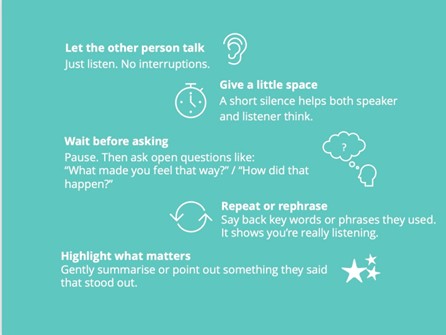
References
Active Listening is a tool adapted by Legacy17 for CLARITY, yet it’s important to recognise that many other versions of active listening exist – as it rightly should. Listening is one of the most vital elements of communication, and a diversity of approaches helps meet different needs and contexts.
- For further reading and deeper instructions please follow the link: https://hostingtransformation.eu/method/30187/
- Center, N. P., & Borhan, C. (2022). Those who Listen, Change the World: The Little Book on Dialogue.
Download the Activity Card here
Activity 3.3.2 Deep listening with Others
Overview
Listening deeply to others is a skill that can help older learners, and teachers, to access empathy and deep levels of intuition, for instance in order to clarify questions, nourish relationships, and generate new ideas. It can be used for peer coaching. Fundamental to the method is the willingness to practise removing inner censorship and other obstacles to hearing what the other person means, and not just what they say. It is not something you learn overnight. Conversely, it is something that everyone can do, with practice.
Curriculum linkage
- Language & Literature,Physical Education & Health (wellbeing and mindfulness), Civics & Social Studies , Cross-Curricular & Global Competencies, Ethics, Religion & Philosophy
Competences built
- Empathy, presence, self-reflection, deep listening, integrity, perspective taking
Basic info
- Age range: 15+
- Duration: 5 minutes/person
- Group size: no immediate limit; break-out groups of 2 or 3 people.
- Level of difficulty: Intermediate
- Materials/space required:
- Indoor or outdoor space that gives room for private reflection.
- If you use chairs, arrange them so the learners are not facing each other.
- Paper and pen for noting personal questions and reflections.
- Timer for timekeeping
- Location: Indoors or outdoors
Prep Work
Prepare a prompt for the learners to put into their own words. For example, in connection with an exercise focused on values, you might start by suggesting ‘What do I most value in nature?’ or ‘My experience with an animal (or a specific place)’.
During the introduction of the exercise the learners are invited to rephrase until the question resonates with them and their situation.
Also prepare and rehearse any introduction that brings the listener towards the point of inner silence. This should be used in step 3 ‘prepare for listening’. As a suggestion for such an instruction please see the script for “Entering your inner silence” provided in Activity 3.3.3 Deep Listening to yourself.
Steps in the activity
- Introducing the exercise
- Preparing for listening
- Listening – to your partner/partners
- Plenary reflections
- Noting reflections
Steps
Step 1: Introduction to the exercise
- Make sure this activity is practised on a voluntary basis, by letting the learners know what it is about. Let them know that all information exchanged through the exercise should remain confidential.
- Introduce five modes of listening. Deep Listening can be described as five modes of listening. As a beginner it can be good to practise them one at a time, and to start with the first mode of listening (‘be silence’). When more experienced, you can weave them together. The different modes of listening are:
- Be silence: Do not respond in any way to the speaker, either with words or with body language. Look away. No eye contact.
- Give attention: Focus your entire self on what the speaker is saying, to the exclusion of all else.
- Be empathic: Enter the talker’s story and – to the extent that feels comfortable for you – live it as your own. Feel it in your body, your mind, your spirit, as if you were living the story. Be aware, however, that it is still the speaker’s story, not yours; if the speaker is distressed, maintain a ‘safe’ distance, for instance through a breathing exercise, movement, or other ways you find useful for regulating your own emotions.
- Be non-judgmental: This can be a difficult practice when the talker offers images (values, ideas, intentions) in conflict with yours!
- Be ‘empty’: Put aside (‘park’) your present: your longings, knowledge and experience, hopes, dreams, problems, visions.
Step 2: Preparing for listening
- Explain the deep listening exercise. In a nutshell, tell the learners to not respond to the speaker, and not engage in a dialogue.
- Invite learners to walk side by side during the exercise, or position chairs/seating so that they do not easily see each other.
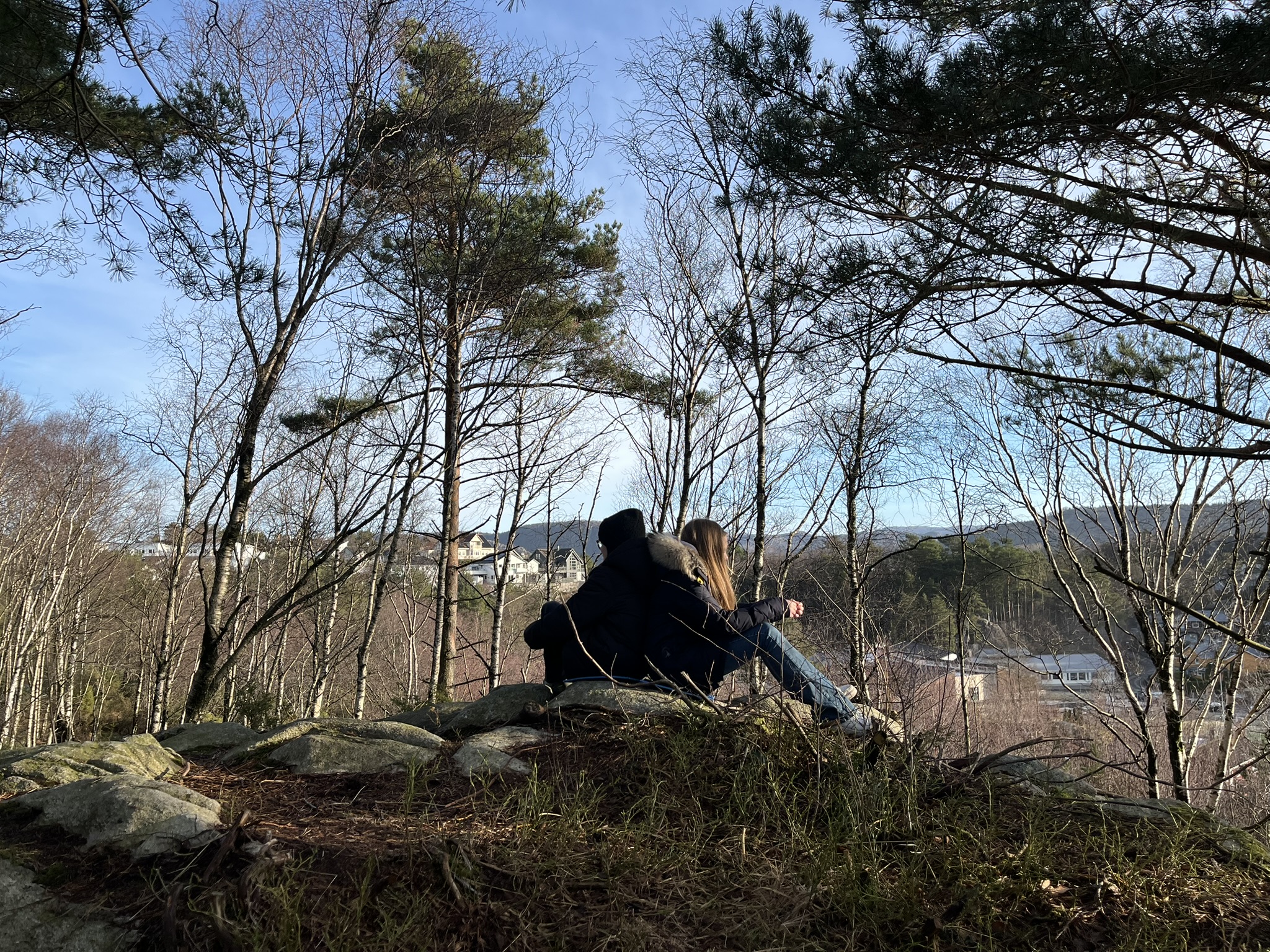
Learners sitting back to back in nature, during a deep listening exercise. Photo: Marte Maurabakken/Climate Creativity.
- Decide on how much time each learner will have to speak.
- Describe the exercise by explaining to the learners they will have to listen deeply to each other in pairs or trios, taking turns to be the speaker, the listener, and (if you are a trio) an observer. Each person in turn has a time (the same for each) to speak; the other(s) practise Deep Listening.
- Ask the learners to decide who will speak first within each pair.
- Explain to learners that if it is their turn to speak and they ‘run out’ of things to say before the end of their time, that’s fine. They can keep silent or speak again when they wish to say something else.
- Explain to learners that they should only say what they feel comfortable saying. If something about the question feels too private or precious to put into words at this moment, they should follow their instincts.
- For the listener, explain that they should start by practising the first mode, ‘Be silence’.
- When there is an observer, explain that the groups should allow 2-3 minutes after each listening session for the observer to express their observations. This is not a place for discussion, but another chance to practise non-judgemental listening.
Step 3: Listening
- Keep track of time.
- Remind the pairs/trios when it is time to change roles.
Step 4: Plenary reflections
- On a voluntary basis, invite a few learners to reflect on their experience as listeners, and comment on the experience of listening without showing a response to what was being said.
- On a voluntary basis, invite a few learners to reflect on their experience as speakers and comment on their experience. Make it clear that you are not inviting them to speak about the content of their own Deep Listening, but about the quality of the experience when speaking about it.
- Invite observers, if any, to say – without judgement – what they observed, and to comment on the ‘observer’ role.
Step 5: Making notes
Learners may be given time to note down personal insights at the end of the process. There is no intended harvest as in gathering content of each learner.
Adaptations
If your learners are younger than 15, then 3.3.1 Active Listening is probably a better choice.
We also invite you to adapt this activity to the specific needs of your learners, including by taking into account their neurodiversity. When adapting tools and activities for neurodivergent learners, please note it is not about treating others how you want to be treated, but how they want to be treated. Ask, listen, and stay open to different ways of learning and engaging.
References
The activity is designed by Legacy17 and based on Deep Listening – a key method of the Enspirited Envisioning program developed and taught by Professor Warren Ziegler, a former teacher of futures studies at Syracuse University, USA. For several decades he worked with workshop learners from the public sector, academia, business, NGOs and Indigenous groups.
For further reading and more detailed instructions:
- https://hostingtransformation.eu/method/30187/
- Center, N. P., & Borhan, C. (2022). Those who Listen, Change the World: The Little Book on Dialogue.
Download the Activity Card here
Activity 3.3.3. Deep Listening to Oneself
Overview
Deep Listening to Oneself: The same basic method is used for this advanced-level skill, as in the Deep Listening to Others activity (3.3.2). It is an effective practice for self-awareness, for improving relationships, for accessing intuition or tacit knowledge, and for making better-informed decisions. You can use this tool for yourself, simply by reading the instructions. Or, you can host a practice session for other educators or for senior learners, following the steps described below.
Curriculum linkage
- Language & Literature,Physical Education & Health (wellbeing and mindfulness), Civics & Social Studies, Cross-Curricular & Global Competencies, Ethics, Religion & Philosophy
Competences built
- Deep listening, Empathy, Compassion; Inner compass, Self reflection
Basic info
- Age range: 15+
- Duration: 10-40 minutes
- Group size: Open
- Level of difficulty: Advanced
- Materials/space required: Private space
- Location: Indoors or outdoors
- Engagement of external stakeholders: No
Prep Work
- For background and context, please read the corresponding section of the Teachers‘ Guide before starting this activity.
Competences/activities to practise first by the teacher:
- Practise Deep Listening to Others (Tool 3.3.2).
Levels in the activity
- Try it yourself
- Guide another person through the same process
- Introduce this tool to a group
Levels and steps
Level 1: Try it yourself
Steps
- Decide how to enter your ‘inner silence’
- Review your regular routines (e.g. yoga, meditation, physical activity…) to identify any activity that helps you reach your own ‘inner silence’.
- Alternatively, consider using the suggested ‘Entering your inner silence’ information, available with the teacher training material.
- Formulate a question to yourself: something you’ve been meaning to ‘ask yourself’, or ‘sleep on’. Write down the question and revise it till it really resonates for you.
- Use your chosen method in order to access your ‘inner silence’. Then drop your question into the silence.
- Allow responses to surface with no censorship. You might ‘hear’ words or other sounds, or see images, whether still or moving. Listen, without judging, but with discernment. Intuitive knowledge never sounds aggressive, and often sounds unexpected, according to Warren Zieler (see references below).
- Feel free to interrupt the process to make notes or sketches. You can return to the process where you left it when the time is right.
- You can also ask yourself new questions, for example to help clarify the responses you get.
- Evaluate the experience. Did you learn anything of use/interest? Was it easy or difficult? This experience may not be immediately fruitful: it may depend on how the question is formulated. However the usefulness of the experience may become more obvious with more practice.
Level 2: Guide another person through the process
- When you have practised enough to feel confident to guide another person through the process, use the same steps as you did for Level 1.
- At Step 3: you may choose (or they may request you) to read aloud the text ‘Entering your inner silence’, as a form of guided visualisation.
- At Step 7: invite the other person to describe their experience. Make it clear that you are not asking them to tell you their question or the responses (though they may choose to do so) but to reflect on the quality of their experience, and any suggestions they may have for improving the process.
Level 3: Introduce this tool in a group
- Explain the basic principles of Deep Listening, and that it is a way of accessing inner/tacit knowledge, or intuition. Introduce 5 modes of Deep Listening, which are:
- Be silence: Do not respond in any way to the speaker, either with words or with body language. Look away. No eye contact.
- Give attention: Focus your entire self on what the speaker is saying, to the exclusion of all else.
- Be empathic: Enter the talker’s story and – to the extent that feels comfortable for you – live it as your own. Feel it in your body, your mind, your spirit, as if you were living the story. Be aware, however, that it is still the speaker’s story, not yours; if the speaker is distressed, maintain a ‘safe’ distance, for instance through a breathing exercise, movement or other ways you find useful for regulating your own emotions.
- Be non-judgmental: This can be a difficult practice when the talker offers images (values, ideas, intentions) in conflict with yours!
- Be ‘empty’: Put aside (‘park’) your present: your longings, knowledge and experience, hopes, dreams, problems, visions.
- Foster a group dialogue in groups of 2-3. Asks the groups to first reflect on and then talk about two questions:
- Question 1. How do you recognise transformative moments – those ‘Aha!’ moments? For example, do you get a particular feeling in your body? Do you hear an inner voice? Do you suddenly see an unusual, unexpected image
- Question 2. Under what circumstances did these signals appear? Are there any particular settings (in the woods, by the sea, during a concert, in contact with small children…) where you experienced a sudden heightening of your senses? Are there moments in a relationship where you have experienced a sudden and completely different connection with the other person? Have there been moments of giddy happiness or imminent danger, when everything became clearer – and different?
- Invite the other(s) to formulate a question for themselves based on the dialogue in Step 1. For instance, “When have I had contact with my inner source of knowledge? Was I paying attention or did I let the message slip by? How did it feel then? What did I hear or see?”
- Invite learners to listen inwardly, in their inner silence, for responses to their questions. If they ask about time, suggest ‘around 10 minutes’. Encourage them to allow whatever happens to happen during that time. And tell them that when deep listening, they may perceive images or words or hear sounds… or nothing. That’s OK. No judgement. Encourage them to take notes at any time and then go back into their quiet self. Use your preferred method to help them to access their inner silence (unless they say they have no need). Invite them to drop their own question into the silence.
- Ask learners to maintain silence for the duration of the exercise (8-15 minutes).
- Watch for signs of completion.
- In pairs or trios: each person in turn tells (in up to 3 minutes each) the main points from their experience. The listeners practise Deep Listening.
Do’s and Don’ts
Do
- Ensure a congenial and comfortable physical environment free of distractions and interruptions.
- Have patience. Deep Listening, whether to oneself or others, is a competence that is acquired over time, with practice.
- Make sure that those you invite to Level 3 are fully committed to the exercise – as an experiment.
Don’t
- Don’t expect to be able to rid yourself (or others) of all preconceived opinions and assumptions, without exception. They will no doubt continue to pop up and surprise you – a valuable learning experience.
- Don’t allow your own hopes and expectations to create pressure on your invitees.
Adaptations
If your audience is new to Deep Listening, we suggest starting with Deep Listening to Others, tool 3.3.2, before trying Deep Listening to Oneself.
We also invite you to adapt this activity to the specific needs of your learners, including by taking into account their neurodiversity. When adapting tools and activities for neurodivergent learners, please note it is not about treating others how you want to be treated, but how they want to be treated. Ask, listen, and stay open to different ways of learning and engaging.
References
The activity is designed by Legacy17 and based on Deep Listening, a key method of the Enspirited Envisioning program developed and taught by Professor Warren Ziegler, a former teacher of futures studies at Syracuse University, USA. For several decades he worked with workshop participants from the public sector, academia, business, NGOs and Indigenous groups.
For further reading and more detailed instructions:
- https://hostingtransformation.eu/method/30187/
- Enspirited Envisioning – a guidebook to the enspiriting approach to the future, Warren Ziegler, 1995
